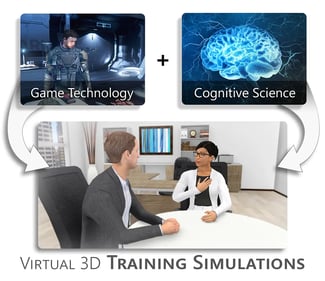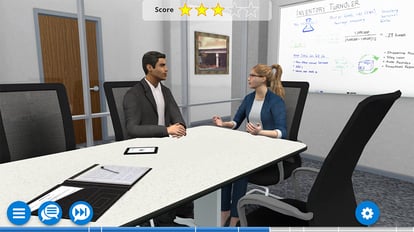
Are your e-learning tools - Articulate, Captivate, iSpring, Elucidat, etc. - giving you the results you want? Are your training programs transferring desired behavior changes to the workplace? If not, it’s likely not the fault of the tool. Your instructional designers may just be expecting more from a tool than it was designed for… like asking a car to fly.
This article will explore why e-learning tools alone do not deliver effective knowledge transfer. Our goal is to show how immersive virtual practice and coaching in realistic environments can facilitate successful transfer to the workplace. We’ll also demonstrate how to solve a common L&D challenge using a 3D immersive learning platform.
3 Reasons E-learning Tools Alone Are Failing to Meet L&D Training Objectives
1. Failure to Solve the Transfer Problem
L&D organizations invest billions of dollars in training annually, yet many trained competencies fail to transfer to the workplace.
Researchers have studied this “transfer problem” and have uncovered reasons for this failure.1 One glaring reason is that most training programs - particularly e-learning programs - do not offer a realistic training environment where workers can practice competencies. Moreover, they’re not coached to achieve competencies within these programs.
For example, an L&D executive at a large healthcare systems company shared a common problem:
“We train them and by the time they return to their jobs, they forgot the training and are back doing what they have always done. What’s the point of this training approach?”
What is missing, is that the learners did not have a chance to practice applying what they learned, or to truly develop and master the skill to use what they learned in real situations.

It’s similar to listening to tennis coaches explain how to hit a forehand and watching them hit some, then, expecting players to go onto the court and hit perfect forehands! Without any practice, the results will undoubtably be dismal.
While immersive, virtual practice and coaching may not help with a forehand. However, we will shortly see that it can be highly effective for most kinds of L&D training.
2. Effective Transfer Focuses on the Experience – Not a Test
It’s quite common to hear that learners just want to get through their e-learning program, or even skip to the questions at the end if they can. If your team is concerned that learners may cheat off each other, that’s a clue that your team is focused on assessment, not knowledge transfer and skill development.
Why? Because knowledge transfer to the workplace is all about the experience. The experience of being immersed in situations and trying to figure out what to do – using old habits and new training. Learners discover what works and what does not (often their old behaviors). It’s not about getting the answers right on a test - that’s how to measure knowledge acquisition. Skill acquisition is measured through performance of those new skills. Done well, this immersion does many things that are highly desirable to your training goals.

Creating an effective learning environment to achieve these benefits requires a completely different approach from knowledge acquisition. We need to focus on learn-by-doing.
3. E-learning Tools Are Not Designed for Practice and Coaching
E-Learning tools are adept at building knowledge and have evolved to combat retention issues (microlearning), and engagement challenges (gamification). Watching videos, working with information in games, and answering questions is a great way to construct knowledge, but falls short in the transfer of its use in real work situations.
E-Learning Tools are designed for knowledge acquisition, not knowledge transfer to the workplace.
Effective Practice and Coaching: While best-practice live training includes authentic practice and coaching to apply knowledge, e-learning tools are simply not equipped to provide an effective alternative. Investing in the human capital to do live practice and coaching is often too expensive. Fortunately, modern immersive learning platforms available today are designed specifically to solve this transfer problem, through virtual “learn-by-doing.”
For a virtual immersive technology solution to be effective, it must emulate great one-on-one practice and coaching with humans. This is a tall order. No wonder 2D simulations with common e-learning tools fall flat. There are certain qualities of the human experience that we must get right in software, for it to be effective.
Qualities that Make a Virtual Immersive Practice and Coaching Solution Effective
Authentic. Realism matters. Learners need to feel like they’re in it. This does not mean they need VR headsets (more on that here), but there must be meaningful immersion. Video, then a question, then more video, or disjointed voice with a textual response that says “incorrect,” is not experiential or memorable.
Conversational. Many critical areas of corporate training involve conversation such as sales, coaching, leadership development, and handling difficult situations. Therefore, fluid conversation between virtual humans that involves the user, creates a dynamic and realistic experience.
Decisions and Feedback. Meaningful decisions, structured around performance gaps, are what drives skill development (if you want to talk about how to do this, e-mail me). Algorithms can be used to provide intelligent, conversational feedback that brings the simulation to life, with embedded coaching.
If you’re thinking your e-learning tools can’t possibly do this, you are correct. More power is needed.
The Winning Combination: Game Technology + Cognitive Science

Achieving the necessary level of realism, responsiveness, and immersion, takes a combination of video game technology to create the experience, and cognitive science learning methodologies, to provide the knowledge transfer.
We’re not talking about building a game here. Rather, we’re utilizing highly sophisticated game technology, to execute learn-by-doing training in an effective way.
Let’s look at a real-world example.
A Real-World Example of Applying Learn-by-Doing Immersive Technology
The Objective: Consistent coaching behaviors across the sales organization.
This is the classic L&D problem, where the training is not effectively transferred. We often hear that organizations try using videos and webinars to reinforce their training, without significant effect. If you made it this far, you know why that’s the case: watching and listening is not learn-by-doing.
The Solution: We need to immerse the sales managers in realistic scenarios where they make decisions, and then use embedded coaching to guide them to recognize optimal paths (i.e. the new coaching process).

In this solution, the AliveSim™ Platform is used to bring these scenarios to life. Conversation with virtual humans, and dynamic responses to a learner’s decisions, provide a scalable resource where learners experience the best way to navigate your organization’s performance gaps.
With this solution, the following training objectives are achieved:
For the Learner
- Gain competence using a new process, via practice with coaching in a safe environment.
- Experience what best practice looks like, and gain the confidence to try it in the workplace.
For the Organization
- Scale virtual practice and coaching, without increasing headcount.
- Achieve consistent learn-by-doing training across the organization.
- Incorporate analytics to identify where learners struggled and measure their success.
For many areas of L&D training, such as leadership development, sales performance, and coaching, effective transfer to the workplace must include a practice and coaching component. Innovative immersive technology, like the AliveSim Platform, provides a scalable, consistent way to include virtual practice and coaching without the need to increase headcount.
Reference
1 Grossman, Rebecca and Eduardo Salas. “The Transfer of Training: What Really Matters.” (2011).
About Syandus: Virtual immersive learning technology that transforms knowledge into real-world performance. We immerse participants in realistic virtual situations with one-on-one expert coaching that gives them experience making optimal decisions. Syandus Learning Modules combine cognitive science principles, the realism of game technology, and our customer’s proprietary content, to deliver rapid skill acquisition. Modules are cloud-based for easy deployment, fully trackable with embedded analytics, and can be used on any web-enabled device.



